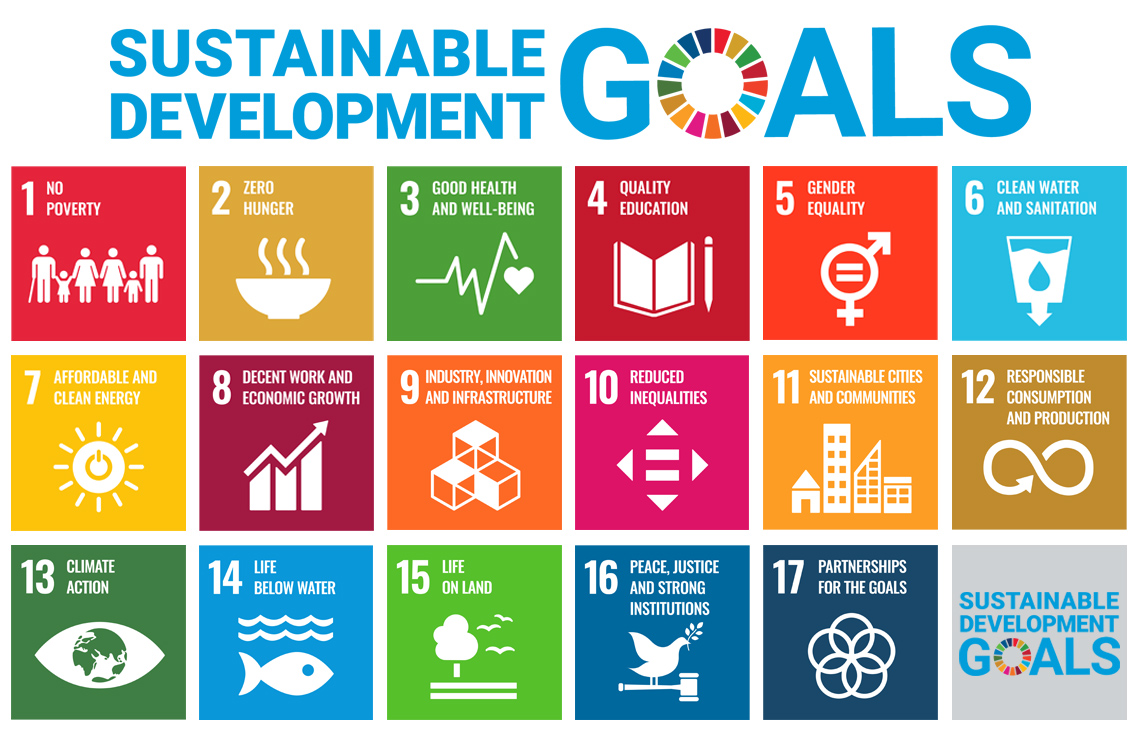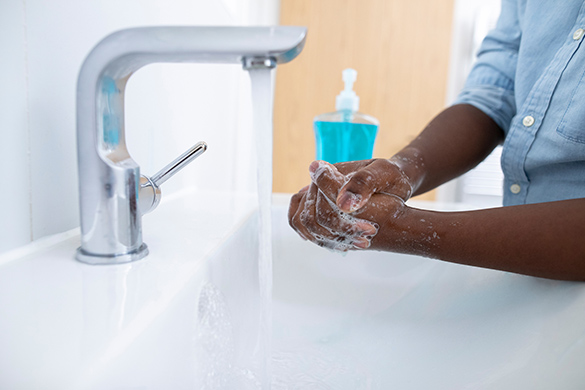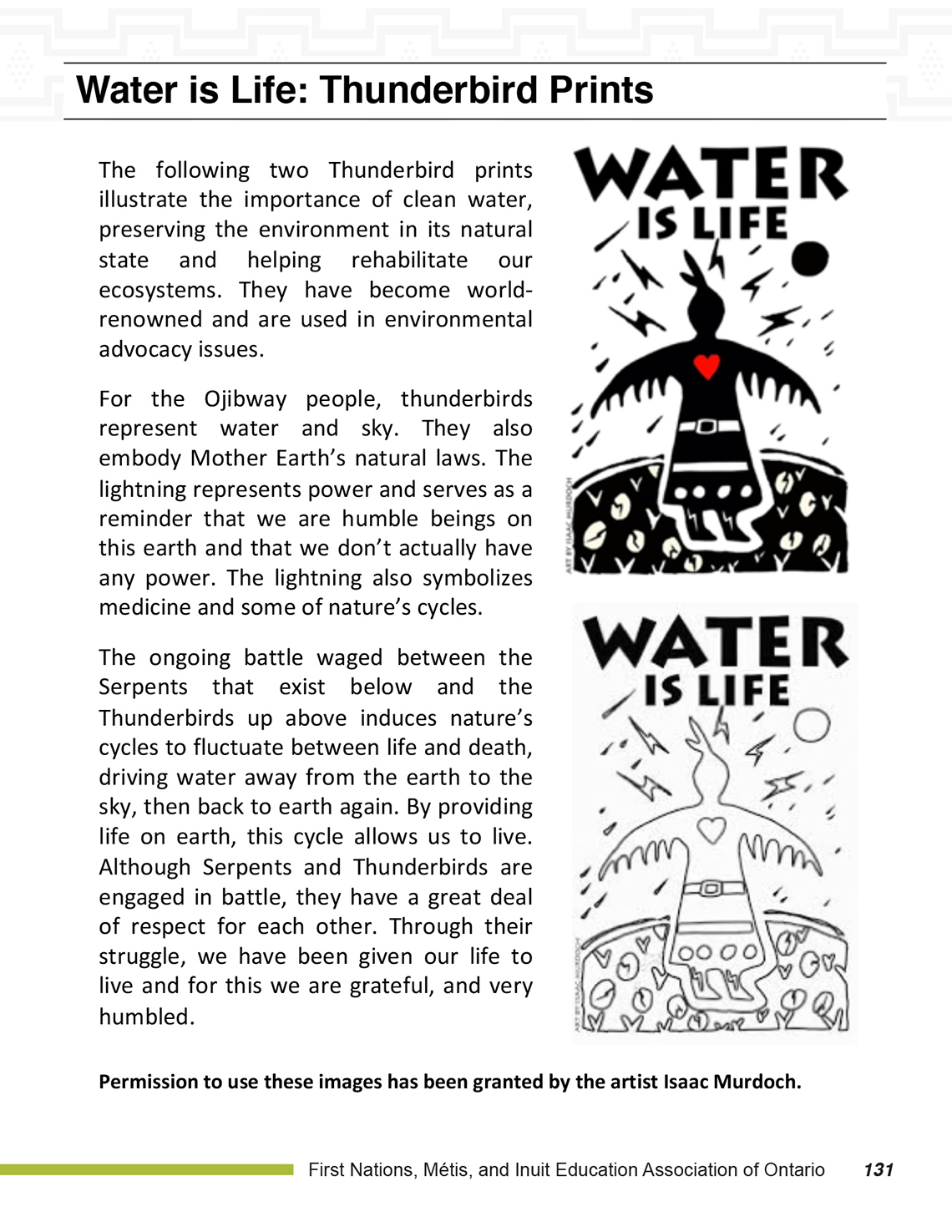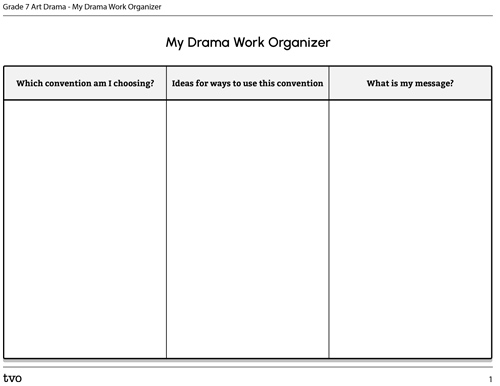Minds On
Warm up

Don’t forget to do your safety check!
Warm Up
Breathing activity
Find a comfortable position. Focus your attention on one part of the body at a time.
How does that part of your body feel? If possible, take a deep breath and allow your lungs to expand.
Focus your attention on one part of your body.
Allow that part to relax before moving on to the next. As you scan through your body, keep breathing deeply. Once you have completed the scan, take a moment to stretch.
Access the following audio recording “Body Part Breathing Activity” to follow this exercise.
Body Part Breathing Activity
Drama game
Explore this video entitled “Follow the Leader” to play a game. In this video, one actor is leading, and one actor is following. They explore different movements and facial expressions together. Try following the leader but create the actions in your own way.
You might try this game with a partner and create your own actions. To end the game, either of you can use the words “end scene.”
Let’s get started
Explore the following short clips about water. As you are exploring, consider what the theme of these clips might be.
Record your ideas in a method of your choice.
Action
Get ready, get set…
The importance of clean water
In 2015, The United Nations developed 17 Sustainable Development Goals with the idea that the countries of the world would work together to solve some of the biggest concerns on the planet.
Press ‘United Nations’ to reveal what this organization is.
The United Nations is an organization that includes 193 countries of the world, including Canada. They aim to maintain international peace, and cooperation amount the countries of the world.
These are the 17 Sustainable Development Goals.

The 17 Sustainable Development Goals are: no poverty, zero hunger, good health and well-being, quality education, gender equality, clean water and sanitation, affordable and clean energy, decent work and economic growth, industry, innovation, and infrastructure, reduced inequalities, sustainable cities and communities, responsible consumption and production, climate action, life below water, life on land, peace, justice, and strong institutions AND partnerships for the goals.
Goal #6 is clean water and sanitation.
This means that the 193 member states of the United Nations believe that it is important for people to have access to clean water. Some of their goals include:
- Achieving global (worldwide) access to safe and affordable drinking water
- Providing sanitation and hygeine for all
- Improving water quality by reducing pollution, eliminating dumping and release of hazardous chemicals into the water
Clean water is a human right. Clean water is a necessity for life.

Clean water is essential for:
- life
- food security
- ecosystems
- education
Around the world, communities are faced with:
- water pollution
- water scarcity (which means a lack of enough water)
- poor or no access to sanitation (disposing of human waste)
- poor or no access to water purification
Test Your Skills
Check your learning!
Use your learning about the UN Sustainable Goal #6 to answer the following questions.
Select the correct answer, then press ‘Check Answer’ to see how you did.
Advocating for clean water
What body or bodies of water are around your community?
In what ways does this water provide for you?
Water is a vital resource. It is a necessity for life. It provides us with:
- the water itself
- food (plants and animals found in the water)
- job opportunities (jobs that are dependent on water)
- cleansing opportunities
- recreation (swimming, boating, fishing, etc.)
- medicine (found in the plants in the water)
- air (water is part of H2O)
Did You Know?
Did you know?
Did you know that freshwater makes up only 3% of all of the water on the planet?
It is a scarce resource in so many areas of the world, which is why it has become a sustainable development goal for the United Nations.
Consider this question: Why do we need to protect the precious freshwater that we do have?

Autumn Peltier is an Anishinaabe youth from Wikwemikong First Nation.
Explore the following video and learn from Autumn’s advocacy to protect the waters.
Autumn shares information about why she is speaking for the water. Some of the issues that she mentions in this video are worldwide issues.
Press the following tabs to learn more about the harm that humans are doing to water.
Water pollution is the introduction of contaminants or toxins to a body of water. This harms the plant and animal life that exist in that water, it destroys habitats, and it limits the water that is healthy for humans to drink.
Factories use water to dispose of their toxic waste and chemicals. There are also accidents such as chemical spills that make their way into the water and contaminate (poison) it. If a factory dumps its waste into a stream, that waste will travel downstream, harming the stream and the life around it, but will also then end up in a larger body of water, continuing its damage.
The trash and litter that is found in large bodies of water has been a worldwide concern for many years. There is another UN Sustainable Development Goal dedicated to life below water (Goal #14). Most of this garbage makes its way to large bodies of water through storm drains and street gutters in the streets, travelling through streams and rivers, or from trash discarded on beaches near the water. Some garbage is also due to the ships that are in the waters. This garbage leaks chemicals into the water itself harming the cleanliness of the water and the plant life in the water.
When a landfill becomes full and begins to spill out into the small towns in rural communities close to the north, there is no support to remove this garbage from potentially finding its way into the water. Once it enters the water, it leaks chemicals and toxins into the water which is the supply for these northern towns who now do not have access to clean water.
Pause and Reflect
Reflection question
Why would Autumn want to speak to the Prime Minister of Canada about these issues?
Record your ideas using a method of your choice.
Another perspective
Artist Isaac Murdoch created two Thunderbird prints that illustrate the importance of clean water, which are shared in this image and transcript.

This is a photo taken from the FNMIEAO site. It is a resource titled “Water is Life: Thunderbird Prints”. The following is what is written in the document.
“The following two Thunderbirds prints illustrate the important of clean water, preserving the environment in its natural state and helping rehabilitate our ecosystems. They have become world renowned and are used in environmental advocacy issues. For the Ojibway people, thunderbirds represent water and sky. They also embody Mother Earth’s natural laws. The lightning represents power and serves as a reminder that we are humble beings on this earth and that we don’t actually have any power. The lightning also symbolizes medicine and some of nature’s cycles. The ongoing battle waged between the Serpents that exist below and the Thunderbirds up above induces nature’s cycle to fluctuate between life and death, driving water away from the earth to the sky, then back to earth again. By providing life on earth, this cycle allows us to live. Although Serpents and Thunderbirds are engaged in battle, they have a great deal of respect for each other. Through their struggle, we have been given our life to live and for this we are grateful, and very humbled.”
Source: FNMIEAO, Water is Life: Thunderbird Prints
Press the ‘Activity’ button to access Water is Life: Thunderbird Prints.
Pause and Reflect
Reflection question
How does Isaac Murdoch’s Thunderbird prints relate to Autumn’s advocacy work? How does this help illustrate the importance of water?
Record your ideas using a method of your choice.
Go!
Drama is used to express personal opinions, to analyze issues, and to build empathy.
Creating drama about advocating for water
How can we use drama to advocate for the protection of clean water?
It is important to send a clear message. This is a call to action! How can we support Autumn’s advocacy work?
Drama is an opportunity to raise one’s voice. It gives the confidence to share a message and feel a sense of responsibility about an issue. It gives a stage and a platform to educate others about important messages for change.

CONSIDER: What is your overall message you want to communicate about clean water?
Record some ideas for your overall message using a method of your choice.
Press ‘Example’ to access possible responses.
As humans, we are putting communities’ access to clean water at risk. We need to know of the damage we are causing through our actions.
Using drama, I want to share this information, using the stage as a platform to create change.
Conventions of drama
How can the following conventions of drama to convey a strong message and spread the word of the importance of clean water?
Explore the conventions of drama and consider how and if each convention can help send your message.
Tableau
Tableau is a group of silent, motionless figures used to represent a scene, theme, or abstract idea (e.g., peace, joy), or an important moment in a narrative. Tableaux may be presented as stand-alone images to communicate one specific message or may be used to achieve particular effects in a longer drama work. Important features of a tableau include character, space, gesture, facial expressions, and levels.
Explore this video entitled “What is a Tableau?” to learn about the four different features of a tableau. The four features are stillness, facial expressions, filling the space, and levels.
What kind of moments could you share about clean water through tableau?
Press ‘Example’ to reveal a possible answer.
Through tableaux, I could show the four areas of harm that are outlined by Autumn and expanded in this learning activity and then as the fifth moment, I could create an image of the harm these choices are doing.
Mime
Mime is the use of gesture, movement, and facial expression without words or sounds to communicate actions, character, relationships, or emotion.
Explore this example of a mime performance.
What kind of message could you share about clean water through mime?
Press ‘Example’ to reveal a possible answer.
Through mime, I could narrate a script about a body of water that is being damaged by all 4 reasons that Autumn pointed to in her video and are expanded on in this learning activity. As the narration is happening, someone could mime the actions using body and facial expressions and through the use of props.
Monologue
A monologue is a long speech by one character in a drama, intended to provide insight into the character.
Explore this video entitled “What is a Monologue” to learn more about how actors use monologue to communicate their ideas and emotions to the audience.
What kind of message could you share about clean water through monologue?
Press ‘Example’ to reveal a possible answer.
Through monologue, I could become the water itself and through my actions, face, and voice, I could share what is happening to me, becoming ill, while describing the actions that are causing my illness.
Narration
Narration is a convention in which a speaker describes the action that is occurring in a drama. Instead of creating dialogue, a playwright could decide to tell the story through the use of narration.
Explore this example narration audio clip for “The Wasps, the Bees and the Hornet.”
The Wasps, the Bees and the Hornet
What kind of message could you share about clean water through narration?
Press ‘Example’ to reveal a possible answer.
Through narration, I could share a story of a body of water and what is happening to them because of the actions of humans that are outlined by Autumn and expanded on in this learning activity.
Visual aids/props
Visual aids are pictures, projections, or objects used to enhance drama performances.
A prop is a portable object used in a drama to support the action or to give authenticity to the setting.
Explore this video entitled “Props” to learn more about how actors use props to get into character.
What kind of message could you share about clean water through visual aids/props?
Press ‘Example’ to reveal a possible answer.
Through visual aids and props, I could lay out symbols for each of the four areas of harm that are outlined by Autumn and expanded in this learning activity. These could be oil drums or a bucket of filthy water. It could be empty plastic water bottles, and a tube that could represent the dumping. I could do this while explaining what each prop is and how it is harming the water and what the issue with that is.
Soundscapes/sound effects/musical accompaniment
A soundscape or sound collage is a combination of sounds used to create an atmosphere or to enhance important moments of a scene using voice and/or instruments.
Musical accompaniment includes musical scores (compositions) or songs are added to a production to also create an atmosphere.
Using artificial sounds artistically in performance is referred to as sound effects.
Explore the following video to learn more about how sound effects are made.
What kind of message could you share about clean water through sound effects/soundscapes/musical accompaniment?
Press ‘Example’ to reveal a possible answer.
Through sound effects, soundscapes, and/musical accompaniment, I could have images for each of the four areas of harm that are outlined by Autumn and expanded in this learning activity and create a sound effect for each of these areas of harm. I would like to also have dramatic music playing in the background.
Choose one of the conventions of drama to make a plan for a drama work that could be your call to action!
My drama convention of choice is
Using a method of your choice, or the planning tool provided, plan your ideas.
- What convention are you choosing?
- What ideas do you have for ways to use this convention to share your message?
- What is your message?
Complete the My Drama Work Organizer in your notebook or using the following fillable and printable document. You can also use another method of your choice to record your thoughts.
Consider adding your work to your drama portfolio.
If possible, share your plan with a partner. Discuss your choices and what you are hoping to communicate through this drama work.
Pause and Reflect
Reflection question
How did your understanding of the various perspectives of the UN Sustainable Development Goal, Autumn Peltier’s message and Isaac Murdoch’s Thunderbirds help you shape your drama work?
Record your thoughts using a method of your choice.
Consolidation
Putting it all together
In 2019, Autumn Peltier had the opportunity to speak at the United Nations Global Landscapes Forum and continues to speak today on behalf of the water.
Access this video “Water Protector” to learn more about what Autumn Peltier spoke about.
Consider Autumn’s continued work as you finalize your call-to-action-drama work!
Your turn
You are ready to create your call to action!
Now that you have planned and carefully thought out how you would like to communicate your message, it is time to put it together.
You can perform your drama work to a partner when you are ready or create a video of your performance.
If you choose to present your drama work but not in a performance, you can create a slide show, use drawings of your work, or present your materials along with your explanation.

Pause and Reflect
Personal reflection
Was this an area of drama in which you felt confident? Why or why not?
What did you enjoy the most about this activity? Why?
What is one thing in this area of drama that you would like to continue to practise? Why?
Portfolio
Journal reflection
Reflect on the learning tasks. This reflection is a space for you to express your feelings, ask questions about what you have just done, and connect thoughts together with specific activities or exercises.
Use 2-4 of the journal prompts from the Reflection Starters list and create a written, audio, or video reflection.
|
Prompts to Start a Reflection on Drama Class Note: The following prompts begin an entire thought and can be used to develop your thoughts and ideas. Note: Try to utilize two to four of the prompts provided. If there is something else you wish to share, continue to build on your ideas. Note: Explore your thoughts and feelings with direct reference to what you learned and explored within the lesson. When I did (Blank), it reminded me of… I really liked it when I did (Blank), because… I am excited to explore (Blank), because… When I think about what I accomplished in this task, I think about… When I learned about (Blank), it made me feel (Blank), because… Three words I would use to describe this/these task(s) are (Blank), (Blank), and (Blank) because… |
Press the ‘Activity’ button to access Reflection Starters.
Reflection
As you read the following descriptions, select the one that best describes your current understanding of the learning in this activity. Press the corresponding button once you have made your choice.
I feel…
Now, expand on your ideas by recording your thoughts using a voice recorder, speech-to-text, or writing tool.
When you review your notes on this learning activity later, reflect on whether you would select a different description based on your further review of the material in this learning activity.
